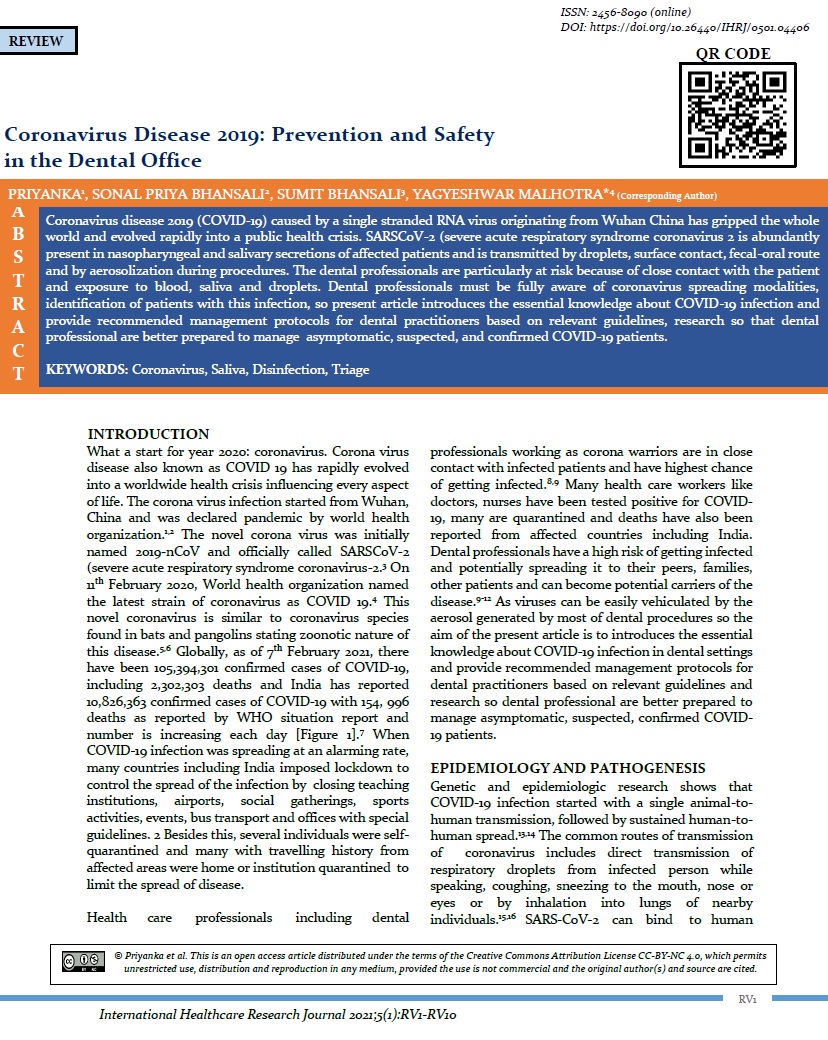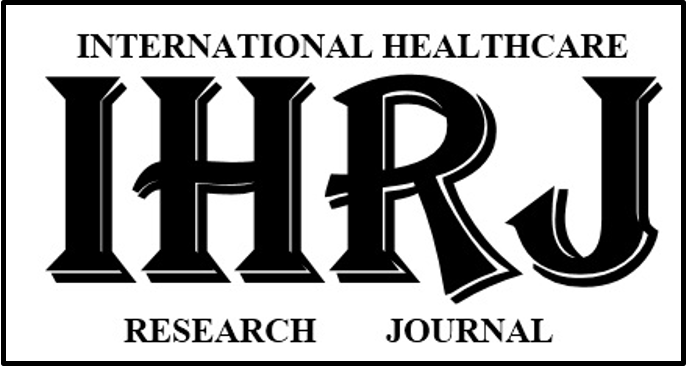Coronavirus Disease 2019: Prevention and Safety in the Dental Office
Abstract
Coronavirus disease 2019 (COVID-19) caused by a single stranded RNA virus originating from Wuhan China has gripped the whole world and evolved rapidly into a public health crisis. SARSCoV-2 (severe acute respiratory syndrome coronavirus 2 is abundantly present in nasopharyngeal and salivary secretions of affected patients and is transmitted by droplets, surface contact, fecal-oral route and by aerosolization during procedures. The dental professionals are particularly at risk because of close contact with the patient and exposure to blood, saliva and droplets. Dental professionals must be fully aware of coronavirus spreading modalities, identification of patients with this infection, so present article introduces the essential knowledge about COVID-19 infection and provide recommended management protocols for dental practitioners based on relevant guidelines, research so that dental professional are better prepared to manage asymptomatic, suspected, and confirmed COVID-19 patients.
Downloads
References
Phelan AL, Katz R, Gostin LO. The novel coronavirus originating in Wuhan, China: challenges for global health governance. JAMA 2020; 323: 709-10.
World Health Organization (WHO) Coronavirus Disease (COVID-19) Pandemic. (Online Article): Available from: https://wwwwhoint/emergencies/diseases/novel-coronavirus-2019. [Last Accessed on 15th January, 2021]
Gorbalenya AE, Baker SC, Baric RS, Groot RJ. The species Severe acute respiratory syndrome related coronavirus: classifying 2019-nCoV and naming it SARS-CoV-2. Nat Microbiol. 5(5) 2020. https://doi.org/10.1038/s41564-020-0695-z.
Mahase E. China coronavirus: WHO declares international emergency as death toll exceeds 200. BMJ. 2020;368:m408. https://doi.org/10.1136/bmj.m408.
Zhou P, Yang X-L, Wang X-G, Hu B , Zhang L , Zhang W , et al. A pneumonia outbreak associated with a new coronavirus of probable bat origin. Nature 2020;579:270-3.
Wahba L, Jain N, Fire AZ, , Shoura MJ,Artiles KL, McCoy MJ,et al. Identification of a pangolin niche for a 2019-nCoV-like coronavirus through an extensive meta metagenomic search. BioRxiv 2020. https://doi.org/10.1101/2020.02.08.939660.
World Health Organisation- coronavirus disease (COVID-19) situation report –283
Ather A, Patel B, Ruparel NB, Diogenes A, Hargreaves K.M. Coronavirus Disease 19 (COVID-19): Implications for Clinical Dental Care. J Endod. 2020;46:1-11.
Meng L, Hua F, Bian Z. Coronavirus Disease 2019 (COVID-19): Emerging and Future Challenges for Dental and Oral Medicine. J Dent Res. 2020;99(5):481-7.
Gamio L. The workers who face the greatest risk. The New York Times. Online Article. Available from: https://www.nytimes.com/interactive/2020/03/15/business/economy/coronavirus-worker-risk.html. [Last Accessed on February 1st, 2021.]
Peng X, Xu X, Li Y, Cheng L, Zhou X, Ren B. Transmission routes of 2019-nCoV and controls in dental practice. Int J Oral Sci. 2020;12(1):9. https://doi.org/10.1038/s41368-020-0075-9.
Xu H, Zhong L, Deng J, Peng J, Dan H, Zeng X, Li T, et al. High expression of ACE2 receptor of 2019-nCoV on the epithelial cells of oral mucosa. Int J Oral Sci. 2020; 12(1):8. https://doi.org/10.1038/s41368-020-0074-x.
Chen N, Zhou M, Dong X, Qu J, Gong F, Han Y, et al. Epidemiological and clinical characteristics of 99 cases of 2019 novel coronavirus pneumonia in Wuhan, China: a descriptive study. Lancet 2020; 395:507–13. https://doi.org/10.1016/S0140-6736(20)30211-7.
Rio DC, Malani PN. 2019 novel coronavirus-important information for clinician. JAMA 2020;23(11):1039–40. https://doi.org/10.1001/jama.2020.1490.
Centers for Disease Control and Prevention. Transmission of coronavirus disease 2019 (COVID). (Online Article). Available from: https://www.cdc.gov/coronavirus/2019nCoV/about/transmission.html. [Last Accessed on February 25th, 2021.]
Lu CW, Liu XF, Jia ZF. 2019-nCoV transmission through the ocular surface must not be ignored. Lancet. 2020;395 (10224):e39. https://doi.org/10.1016/S0140-6736(20)30313-5
To KK, Tsang OT, Yip CC, Chan K , Wu T , Chan JMC, et al. Consistent detection of 2019 novel coronavirus in saliva. Clin Infect Dis. 2020;ciaa149. https://doi.org/10.1093/cid/ciaa149.
Xu R, Cui B, Duan X, Zhang P, Zhou X and Yuan Q. Saliva: potential diagnostic value and transmission of 2019-nCoV. Int J of Oral Sci. 2020;12(1):11. https://doi.org/10.1038/s 41368-020-0080-z.
Sabino-Silva R, Jardim ACG, Siqueira WL. Coronavirus COVID-19 impacts to dentistry and potential salivary diagnosis. Clin Oral Investig. 2020:1-3. https://doi.org /10.1007/s00784-020-03248-x.
Zhang J, Wang S, Xue Y. Fecal specimen diagnosis 2019 novel coronavirus–infected pneumonia. J Med Virol. 2020;92:680-2. https://doi.org/10.1002/jmv.25742
Rothe C, Schunk M, Sothmann P,Gisela Bretzel G,Froeschl G, Wallrauch C, et al. Transmission of 2019-nCoV infection from an asymptomatic contact in Germany. N Engl J Med. 2020;382:970–1. https://doi.org/10.1056/NEJMc2001468
Backer JA, Klinkenberg D, Wallinga J. Incubation period of 2019 novel coronavirus (2019-nCoV) infections among travellers from Wuhan, China, 20–28 January 2020.Euro Surveill. 2020;25(5):2000062. https://doi.org/10.2807/1560-7917.ES.2020.25.5.20000 62.
Li Q, Guan X, Wu P, Wang X, Zhou L, Tong Y, et al. Early transmission dynamics in Wuhan, China, of novel coronavirus-infected pneumonia. N Engl J Med.2020;382(13):1199-207. https://doi.org/10.1056/NEJMoa2001316.
Wang D, Hu B, Hu C, Zhu F, Liu X, Zhang J, et al. Clinical characteristics of 138 hospitalized patients with 2019 novel coronavirus–infected pneumonia in Wuhan, JAMA 2020;323: 1061-9. https://doi.org/10.1001/jama.2020.1585
Yang Y, Lu Q, Liu M, Wang Y, Zhang A, Jalali N, et al. Epidemiological and clinical features of the 2019 novel coronavirus outbreak in China. medRxiv. https://doi.org/10.1101/2020.1102.1110.20021675.
Liu L, Liu L, Wei Q, Alvarez X, Wang H, Du Y, Zhu H, et al. Epithelial cells lining salivary gland ducts are early target cells of severe acute respiratory syndrome coronavirus infection in the upper respiratory tracts of rhesus macaques. Journal of Virology 2011;85(8):4025-30; https://doi.org/10.1128/JVI.02292-10
Kampf G, Todt D, Pfaender S, Steinmann E. Persistence of coronaviruses on inanimate surfaces and its inactivation with biocidal agents. J Hosp Infect. 2020;104:246-51. https://doi.org/10.1016/j.jhin.2020.01.022
Chen J. Pathogenicity and transmissibility of 2019-nCoV—a quick overview and comparison with other emerging viruses. Microbes Infect. 2020;22:69-71. https://doi.org/10.1016/j.micinf.2020.01.004
Cleveland JL, Gray SK, Harte JA,Robison VA, Moorman AC, Gooch BF. Transmission of blood-borne pathogens in US dental health care settings: 2016 update. J Am Dent Assoc.2016;147:729-38. https://doi.org/10.1016/j.adaj.2016.03.020
Harrel SK, Molinari J. Aerosols and splatter in dentistry: a brief review of the literature and infection control implications. J Am Dent Assoc. 2004;135(4): 429–37. https://doi.org/10.14219/jada.archive.2004.0207
Huang C, Wang Y, Li X, Ren L, Zhao J, Hu Y, et al . Clinical features of patients infected with 2019 novel coronavirus in Wuhan, China. Lancet. 2020;395:497–506. https://doi.org/10.1016/S0140-6736(20)30183-5.
Giacomelli A, Pezzati L, Conti F, Bernacchia D, Siano M, Oreni L, et al. Self-reported olfactory and taste disorders in SARSCoV- 2 patients: a cross-sectional study. Clin Infect Dis. 2020;ciaa330. https://doi.org/10.1093/cid/ciaa330.
Guan W-J, Ni Z-Y, Hu Y, Liang W-H, Ou C-Q, He J-X, et al. Clinical characteristics of 2019 novel coronavirus infection in China. N Engl J Med. 2020;382:1708-20. https://doi.org/10.1056/NEJMoa2002032
World Health Organization. Clinical Management of Severe Acute Respiratory Infection When Novel Coronavirus (2019-nCoV) Infection Is Suspected: Interim Guidance 28th January 2020. (Online Article). Available from: https://apps.who.int/iris/handle/10665/330893. [Last Accessed on 25th January, 2021]
Lu B, Huang Y, Huang L, Li B, Zheng Z, Chen Z, et al. Effect of mucosal and systemic immunization with virus‐like particles of severe acute respiratory syndrome coronavirus in mice. Immunology 2010;130:254-61.
Indian Council of Medical Research. Recommendation for Empiric use of Hydroxy Chloroquine for Prophylaxis of SARS-CoV-2Infection. (Online PDF). Available from: https://www.icmr.gov.in/sites%20/default/files/upload%20documents/HCQ_Recommendation_22March%20final_MM_V1.pdf . [Last Accessed on 25th January, 2021]
Gautret P, Lagier JC, Parola P, Meddeb L, Mailhe M, Doudier B, et al.Hydroxychloroquine and azithromycin as a treatment of COVID-19: results of an open-label non-randomized clinical trial. Int J Antimicrob Agents. 2020;105949. https://doi.org/10.1016/j.ijantimicag.2020.105949.
Marano G, Vaglio S, Pupella S, Facco G, Catalano L, Liumbruno GM, et al. Convalescent plasma: new evidence for an old therapeutic tool? Blood Transfus. 2016;14:152-7.
Ather A, Patel B, Ruparel NB, Diogenes A, Hargreaves KM. Coronavirus Disease 19 (COVID-19): Implications for Clinical Dental Care. J Endod. 2020; 46:584-595. https://doi.org/10.1016/j.joen.2020.03.008
American Dental Association. ADA Develops Guidance on Dental Emergency, Nonemergency Care. (Online Article). Available from: https://www.ada.org/en/publications/ada-news/2020-archive/march/ada-developsguidance-on-dental-emergency-nonemergency-care. Accessed on May 25, 2020. [Last Accessed on 27th January, 2021]
American dental association. What Constitutes a Dental Emergency?. (Online Article). Available from: https//www.success.ada.org.files.ADA _COVID19_dental emergency. [Last Accessed on 27th January, 2021]
Dental Council of India. Precautionary and preventive measures to prevent spreading of novel coronavirus (COVID-19). (Online PDF). Available from: http:// dciindia.gov.in/Admin/NewsArchives/L.No._8855. [Last Accessed on 27th January, 2021]
Indian Dental Association. Indian Dental Association’s Preventive Guidelines for Dental Professionals on the Coronavirus Threat. (Online article). Available from: https://www.ida.org.in/pdf/IDA_Recommendations_for_Dental_Professionals_on_the_Coronavirus_Threat. [Last Accessed on 28th January, 2021]
American Dental Association. ADA recommending dentists postpone elective procedures. (Online article). Available from: https://www.ada.org/en/publications/ada-news/2020-archive/march/adarecommending-dentists-postpone-elective-procedures. [Last Accessed on 28th January, 2021]
Centers for Disease Control and Prevention. Infection control: severe acute respiratory syndrome coronavirus 2 (SARS-CoV-2) (Online article). Available from: https://www.cdc.gov/coronavirus/2019-ncov/infection-control/control-recommendations.html. [Last Accessed on 28th January, 2021]
Government of India. Ministry of Health and Family Welfare (MOHFW). Guidelines for dental professionals in COVID 19 pandemic situation. (Online PDF). Available from: mohfw.gov.in/pdf/DentalAdvisoryF.pdf. [Last Accessed on 28th January, 2021]
Centers for Disease Control and Prevention. Stop the Spread of Germs. (Online PDF). Available from: https://www.cdc.gov/coronavirus/2019-ncov/downloads/stop-the-spread-of-germs.pdf.
Xiao WJ, Wang ML, Wei W, Wang J, Zhao J, Yi B, et al. Detection of Sars-CoV and RNA on aerosol samples from SARS patients admitted to hospital. Zhonghua Liu Xing Bing Xue Za Zhi. 2004; 25 :882-5.
Kariwa H, Fujii N, Takashima I. Inactivation of SARS coronavirus by means of povidone-iodine, physical conditions, and chemical reagents. Jpn J Vet Res. 2004;52:105–12.
Centers for Disease Control and Prevention. Guidance for Dental Settings https://www.cdc.gov/coronavirus/2019-ncov/hcp/dental-settings.html. [Last Accessed on 28th January, 2021]
Li JO, Chen Y, Ting DSW. Novel Coronavirus disease 2019 (COVID-19): The importance of recognizing possible early ocular manifestation and using protective eyewear. Br J Ophthalmol. 2020; 104: 297-98. https://doi.org/10.1136/bjophthalmol-2020-315994
Siegel JD, Rhinehart E, Jackson M, Chiarello L, the Healthcare Infection Control Practices Advisory Committee. 2007 Guideline for Isolation Precautions: Preventing Transmission of Infectious Agents in Healthcare Settings. (Online article). Available from: https://www.cdc.gov/infectioncontrol/guidelines/isolation/index.html. [Last Accessed on 28th January, 2021]
Samaranayake LP, Reid J, Evans D. The efficacy of rubber dam isolation in reducing atmospheric bacterial contamination. ASDC J. Dent. Child. 1989;56:442–4.
Samaranayake LP, Peiris M. Severe acute respiratory syndrome and dentistry:a retrospective view. J Am Dent Assoc. 2004;13:1292–302.
Barenghi L, Barenghi A, Cadeo C, Di Blasio A. Innovation by computer-aided design/computer-aided manufacturing technology: a look at infection prevention in dental settings. Biomed Res Int. 2019; 2019:6092018. https://doi.org/10.1155/2019/6092018.
Otter JA, Donskey C, Yezli S , Douthwaite S, Goldenberg SD ,Weber DJ. Transmission of SARS and MERS coronaviruses and influenza virus in healthcare settings: the possible role of dry surface contamination. J Hosp Infect.2016; 92:235–50.
World Health Organization. Infection prevention and control during health care when novel coronavirus (nCoV) infection is suspected. Interim guidance.25 January 2020. (Online article). Available from: https://apps.who.int/iris/handle/10665/330674. [Last Accessed on 28th January, 2021]

Copyright (c) 2021 Priyanka et al.

This work is licensed under a Creative Commons Attribution-NonCommercial 4.0 International License.


